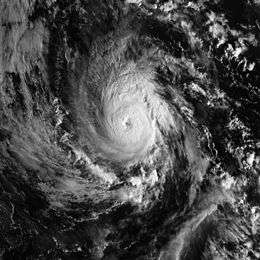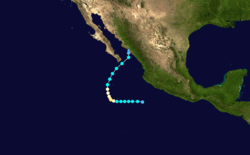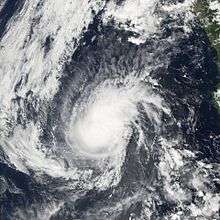Hurricane Paul (2006)
Hurricane Paul was a hurricane that ultimately struck Mexico as a tropical depression in October 2006. It developed from an area of disturbed weather on October 21, and slowly intensified as it moved into an area of warm waters and progressively decreasing wind shear. Paul attained hurricane status on October 23, and later that day it reached its peak intensity of 105 mph (165 km/h), a strong Category 2 hurricane on the Saffir-Simpson scale. A strong trough turned the hurricane to the north and northeast into an area of strong vertical shear, and Paul weakened to a tropical storm on October 24. It accelerated northeastward, and after passing a short distance south of Baja California Sur the low level circulation became decoupled from the rest of the convection. Paul weakened to a tropical depression on October 25 a short distance off the coast of Mexico, and after briefly turning away from the coast it made landfall on northwestern Sinaloa on October 26.
| Category 2 hurricane (SSHWS/NWS) | |
 Hurricane Paul at peak intensity on October 23 | |
| Formed | October 21, 2006 |
|---|---|
| Dissipated | October 26, 2006 |
| Highest winds | 1-minute sustained: 105 mph (165 km/h) |
| Lowest pressure | 970 mbar (hPa); 28.64 inHg |
| Fatalities | 4 direct |
| Damage | $3.2 million (2006 USD) |
| Areas affected | Oaxaca, Guerrero, Baja California Sur, Sinaloa |
| Part of the 2006 Pacific hurricane season | |
Paul was the third hurricane to threaten western Mexico in the season, the others being Hurricanes John and Lane. Rough surf killed two people along Baja California Sur, while flooding was reported in Sinaloa. Damage totaled more than $35 million (2006 MXN, $3.2 million 2006 USD).
Meteorological history

A tropical wave moved off the coast of Africa on October 4. It moved westward across the Atlantic Ocean without development, and entered the eastern Pacific Ocean on October 18. The next day, it combined with a previously existing area of disturbed weather, resulting in a large area of convection extending northward into southern Mexico.[1] The broad and disorganized system moved westward at 10–15 mph (16–24 km/h).[2] On October 20, the system developed an area of low pressure, and began to show signs of organization.[3] It continued to organize, and developed into Tropical Depression Seventeen-E on October 21 while located about 265 miles (425 km) south-southwest of Manzanillo. Upon forming, the depression possessed a small, tight low-level circulation beneath a well-defined mid-level circulation. Easterly wind shear initially restricted upper-level outflow as the cyclone moved to the west, a motion due to a subtropical ridge to its north.[4]
The cloud pattern of the depression quickly became better organized as a curved band developed around intensifying deep convection, and it is estimated the system intensified into Tropical Storm Paul just six hours after forming. Easterly wind shear exposed the low level circulation to the east of the area of deep convection, though Paul continued to intensify as it moved through an area of warm waters and progressively weakening wind shear.[5] The low level circulation gradually became more embedded within the convection as the cloud pattern improved. Computer models had troubles in forecasting the future of the storm early in its life; the GFDL model forecast Paul to reach winds of 119 mph (191 km/h), while global models expected the system to dissipate in 48–72 hours.[6] Early on October 22, wind shear began to decrease, which coincided with an increase of outflow on its eastern side.[7] The storm temporarily degraded in appearance[8] as it turned to the northwest.[9] However, shear sharply abated over Paul late on October 22, resulting in the storm quickly gaining organization and intensifying. An eye began to develop within the convection,[10] and Paul intensified into a hurricane early on October 23.[11]

Located in an area of warm water temperatures and light wind shear, Hurricane Paul continued to intensify and organize;[11] its well-defined eye was surrounded by a ring of deep convection while outflow remained strong to the north and south.[12] On October 23, while located 465 miles (750 km) south-southwest of Cabo San Lucas, Paul reached its peak intensity of 105 mph (165 km/h), a Category 2 hurricane on the Saffir-Simpson Scale.[1] A large trough located off the west coast of California turned the hurricane to the north-northwest,[13] and later to the north. The combination of increasing shear and dry air quickly weakened Paul[14] to a tropical storm on October 24 as its low-level circulation became detached from the diminishing convection.[15] The storm then turned to the northeast after passing near Socorro Island.[16] Despite increasing wind shear of over 50 mph (80 km/h), Paul remained a tropical storm while its circulation remained on the southwest side of its developing deep convection. Early on October 25, the storm passed about 100 miles (160 km) south of the southern tip of Baja California.[17] The circulation briefly became involved with the deep convection as it accelerated northeastward, though as it approached the coast of Sinaloa, the center again decoupled from the upper level circulation.[18] Later that day, Paul weakened to a tropical depression a short distance off the coast of Mexico, and turned to the north.[19] Early the next day, the depression, devoid of any deep convection, made landfall near Isla Altamura in northwestern Sinaloa. Hours later, the National Hurricane Center issued the last advisory on the dissipating tropical depression.[1][20]
Preparations
As Paul became a hurricane, the government of Mexico issued a hurricane watch for Baja California Sur from Agua Blanca on the west coast to La Paz on the east coast.[21] When a weakening trend was evident as the storm turned to the northeast, the hurricane watch was replaced with a tropical storm warning.[22] 45 hours before the storm struck land, the government of Mexico issued a tropical storm watch from Mazatlán to San Evaristo along the coast of Sinaloa.[22] When Paul was expected to weaken to a tropical depression before landfall, the tropical storm watch for mainland Mexico was discontinued.[23] When Paul retained tropical storm status for longer than expected, and was now expected to make landfall as a tropical storm, a tropical storm warning was issued from Mazatlán to Atlata,[24] which was later discontinued as Paul weakened to a tropical depression.[19]
Emergency officials near the southern tip of Baja California closed schools,[25] while rescue workers ordered for the evacuation of more than 1,500 people from shanty towns. Local police officers went door-to-door to inform the potentially affected residents. Buses carried the evacuated citizens to schools temporarily set up as shelters.[26] A hotel in Cabo San Lucas informed its guests of the approaching storm, and organized indoor activities for those that stayed. Several tourists ended their vacations early and left through local airports.[27] The threat of the storm closed the port at Cabo San Lucas, causing delays in a local fishing competition.[25] In Sinaloa, authorities evacuated over 5,000 families in risk of flooding.[28]
Impact
.jpg)
The National Hurricane Center noted that the precursor disturbance had the potential to drop heavy rainfall which could result in life-threatening flash flooding or mudslides in Oaxaca and Guerrero.[2] However, no damage reports were received there.
In southern Baja California, a fisherman slipped off rocks due to strong seas, while an American tourist was swept out to sea due to rough surf; both were killed.[29] Two others were killed in Sinaloa when their truck was swept away by a swollen river.[30] Paul was the third hurricane in the year to threaten Los Cabos, the others being John and Lane. The hurricane caused little damage in the area, only producing gusty winds and some rainfall.[26] Paul dropped moderate rainfall across mainland Mexico, including a 24-hour total of 2.3 inches (58 mm) in Mazatlán, Sinaloa[31] and over 8 inches (200 mm) in isolated locations.[32] The rainfall led to flooding, the worst of which occurred in Villa Juarez. There, a canal overflowed, while the rainfall flooded streets with up to 3.3 feet (1 m) of water.[28] 5,000 houses were damaged from the flooding, displacing 20,000 people.[33] The storm damaged more than 3,700 acres (15 km2) of crop lands, primarily beans and corn.[32] Damage totaled more than $35 million (2006 MXN, $3.2 million 2006 USD).[34]
See also
- Other storms of the same name
References
- Jamie R. Rhome and Robert J. Berg (2006-11-20). "Hurricane Paul Tropical Cyclone Report" (PDF). National Hurricane Center. Retrieved 2006-11-30.
- Stewart (2006-10-19). "Special Tropical Disturbance Statement". National Hurricane Center. Retrieved 2008-11-22.
- Stewart (2006-10-20). "Tropical Weather Outlook". National Hurricane Center. Retrieved 2006-10-25.
- Stewart (2006-10-21). "Tropical Depression Seventeen-E Discussion One". National Hurricane Center. Retrieved 2006-10-25.
- Avila (2006-10-21). "Tropical Storm Paul Discussion Two". National Hurricane Center. Retrieved 2006-10-25.
- Avila (2006-10-21). "Tropical Storm Paul Discussion Six". National Hurricane Center. Retrieved 2006-10-25.
- Beven (2006-10-22). "Tropical Storm Paul Discussion Four". National Hurricane Center. Retrieved 2006-10-25.
- Franklin (2006-10-22). "Tropical Storm Paul Discussion Five". National Hurricane Center. Retrieved 2006-10-25.
- Rhome & Pasch (2006-10-22). "Tropical Storm Paul Discussion Six". National Hurricane Center. Retrieved 2006-10-25.
- Rhome & Pasch (2006-10-22). "Tropical Storm Paul Discussion Seven". National Hurricane Center. Retrieved 2006-10-25.
- Avila (2006-10-23). "Hurricane Paul Discussion Eight". National Hurricane Center. Retrieved 2006-10-25.
- Franklin (2006-10-23). "Hurricane Paul Discussion Nine". National Hurricane Center. Retrieved 2006-10-25.
- Rhome & Pasch (2006-10-23). "Hurricane Paul Discussion Ten". National Hurricane Center. Retrieved 2006-10-25.
- Rhome/Pasch (2006-10-23). "Hurricane Paul Discussion Eleven". National Hurricane Center. Retrieved 2006-10-25.
- Rhome & Pasch (2006-10-24). "Tropical Storm Paul Discussion Fourteen". National Hurricane Center. Retrieved 2006-10-25.
- Rhome & Pasch (2006-10-24). "Tropical Storm Paul Discussion Fifteen". National Hurricane Center. Retrieved 2006-10-25.
- Avila (2006-10-25). "Tropical Storm Paul Discussion Seventeen". National Hurricane Cente=National Hurricane Center. Retrieved 2006-10-25.
- Rhome & Pasch (2006-10-25). "Tropical Storm Paul Discussion Nineteen". National Hurricane Center. Retrieved 2006-10-25.
- Blake & Franklin (2006-10-25). "Tropical Depression Paul Discussion Twenty". National Hurricane Center. Retrieved 2006-10-26.
- Mainelli (2006-10-26). "Tropical Depression Paul Discussion Twenty-Two". National Hurricane Center. Retrieved 2006-10-26.
- Avila (2006-10-23). "Hurricane Paul Public Advisory Eight". National Hurricane Center. Retrieved 2006-10-25.
- Avila (2006-10-24). "Hurricane Paul Public Advisory Thirteen". National Hurricane Center. Retrieved 2006-10-25.
- Beven & Landsea (2006-10-25). "Hurricane Paul Discussion Sixteen". National Hurricane Center. Retrieved 2006-10-25.
- Rhome & Pasch (2006-10-25). "Hurricane Paul Discussion Eighteen". National Hurricane Center. Retrieved 2006-10-25.
- Frank Jack Daniels (2006-10-25). "Paul fades to tropical storm in run at Mexico". Reuters. Retrieved 2006-10-25.
- Frank Jack Daniels (2006-10-25). "Mexican resort third time lucky as storm misses". Reuters. Archived from the original on 2011-10-02. Retrieved 2006-10-25.
- Staff Writer (2006-10-24). "Hurricane Paul threatens southern Baja California". Associated Press. Retrieved 2006-10-26.
- Mark Stevenson (2006-10-26). "Remnants of Tropical Storm Soak Mexico". Associated Press. Retrieved 2006-10-26.
- Mark Stevenson (2006-10-25). "Tropical Storm Paul Weakens". Associated Press. Retrieved 2006-10-26.
- "Hurricane Paul kills two in northwestern Mexico". Reuters. 2006-10-26. Retrieved 2008-11-21.
- Alex Morales (2006-10-26). "Tropical Depression Paul Rains on Mexico, Weakens Over Land". Bloomberg.com. Archived from the original on 2006-10-27. Retrieved 2006-10-26.
- La Journada (2006-10-26). "Emergencia en 109 municipios de Sinaloa por Paul" (PDF) (in Spanish). Archived from the original (PDF) on November 16, 2006. Retrieved 2006-11-30.
- Dartmouth Flood Observatory (2007-01-25). "2006 Global Register of Major Flood Events". Retrieved 2008-11-21.
- Consejo Directivo del Instituto Sinaloense de Acuacultura (2006). "Acta de la Sesión Ordinaria del Consejo Directivo del Instituto Sinaloense de Actuaculture, Celebrada el Día 10 de Noviembre de 2006, en la Ciudad de Culiacán, Sinaloa" (in Spanish). Archived from the original (DOC) on 2012-02-18. Retrieved 2008-11-17.
External links
| Wikimedia Commons has media related to Hurricane Paul (2006). |
- The NHC's archive on Hurricane Paul.
